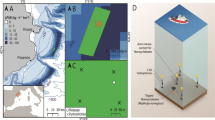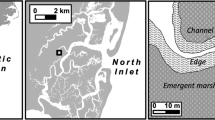Abstract
Acoustic backscatter from an active sonar system over a range of six frequencies between 265 kHz and 3 MHz in the tidally dominated Damariscotta River estuary, Maine, United States, revealed that the major emergence event of the night commenced on the first tidal deceleration after dark (3.5–4 h after local slack), irrespective of flow direction. Emergence traps identified the mysid shrimp,Neomysis americana, as the dominant migrator. Water-column-integrated, acoustically estimated biovolume at our 10-m deep study location increased by a factor of about 6 during these large events, entirely dominating the holoplanktonic contribution and likely being a major component in benthic-pelagic coupling. Application of the same algorithm used to locate this nighttime emergence revealed a parallel but considerably smaller daytime emergence event near the same phase of the tide. Daytime trap samples failed to recover the organisms responsible, but transmissometry rejected the alternative hypothesis that we observed resuspension events. We suspect, but have yet only weak evidence, that animals emerging in daylight are copepods rather than mysids.
Similar content being viewed by others
Literature Cited
Abello, H. U., S. M. Shellito, L. H. Taylor, andP. A. Jumars. 2005. Light-cued emergence and reentry events in a strongly tidal estuary.Estuaries 28:487–499.
Alheit, J. andE. Naylor. 1976. Behavioural basis of intertidal zonation inEurydice pulchra Leach.Journal of Experimental Marine Biology and Ecology 23:135–144.
Benoit-Bird, K. J. andW. W. L. Au. 2002. Energy: Converting from acoustic to biological resource units.Journal of the Acoustical Society of America 111:2070–2075.
Borowsky, B. 1980. Factors that affect juvenile emergence inGammarus palustris.Journal of Experimental Marine Biology and Ecology 42:213–223.
Chatfield, C. 1975. The Analysis of Time Series: Theory and Practice. Chapman and Hall, London, U.K.
Clutter, R. I. andM. Anraku. 1968. Avoidance of samplers, p. 47–76.In D. J. Tranter and J. H. Fraser (eds.), Zooplankton Sampling, Monographs on Oceanographic Methodology, Volume 2. United Nations Educational, Scientific and Cultural Organization, Paris, France.
Greenlaw, C. F. andR. K. Johnson. 1982. Physical and acoustical properties of zooplankton.Journal of the Acoustical Society of America 72:1706–1710.
Greenlaw, C. F. andR. K. Johnson. 1983. Multiple-frequency acoustical estimation.Biological Oceanography 2:227–252.
Hays, G. C., H. Kennedy, andB. W. Frost. 2001. Individual variability in diel vertical migration of a marine copepod: Why some individuals remain at depth while others migrate.Limnology and Oceanography 46:2050–2054.
Holliday, D. V. 1977. Extracting bio-physical information from the acoustic signatures of marine organisms, p. 619–624.In N. R. Andersen and B. J. Zahuranec (eds.), Ocean Sound Scattering Prediction. Plenum Press, New York.
Holliday, D. V. 1993. Zooplankton acoustics, p. 733–740.In B. N. Desai (ed.), Oceanography of the Indian Ocean, A. A. Balkema, Rotterdam, Netherlands.
Kringel, K., D. V. Holliday, andP. A. Jumars. 2003. A shallow scattering layer: High-resolution acoustic analysis of nocturnal vertical migration from the seabed.Limnology, and Oceanography 48:1223–1334.
Lawrie, S. M. andD. G. Raffaelli. 1998. In situ swimming behavior of the amphipodCorophium volutator.Journal of Experimental Marine Biology and Ecology 224:237–251.
Mathworks. 1998. MATLAB: Signal Processing Toolbox. Mathworks, Natick, Massachusetts.
Mayer, L. M., D. W. Townsend, N. R. Pettigrew, T. C. Loder, M. W. Wong, D. Kistner-Morris, A. K. Laursen, A. D. Schoudel, C. Conairis, J. Brown, and C. Newell. 1996. The Kennebec, Sheepscot and Damriscotta River estuaries: Seasonal oceanographic data. University of Maine, Department of Oceanography Technical Report #9601:1-110. Orono, Maine.
McGehee, D. E., R. L. O’Driscoll, andL. V. Martin-Traykovski. 1998. Effects of orientation on acoustic scattering from Antarctic krill at 120 kHz.Deep-Sea Research II 45:1273–1294.
Oishi, K. andM. Saigusa. 1997. Nighttime, emergence patterns of planktonic and benthic crustaceans in a shallow subtidal environment.Journal of Oceanography 53:611–621.
Pieper, R. E. andD. V. Holliday. 1984. Acoustic measurements of zooplankton distributions in the sea.Journal du Conseil pour Exploration de la Mer 41:226–238.
Roast, S. D., J. Widdows, N. Pope, andM. B. Jones. 2004. Sediment-biota interactions: Mysid feeding activity enhances water turbidity and sediment erodability.Marine Ecology Progress Series 128:145–154.
Takahashi, K. andK. Kawaguchi. 1997. Diel and tidal migrations of the sand-burrowing mysidsArchaeomysis kokuboi, A. japonica, andIiella oshimai, in Otuschi Bay, northeastern Japan.Marine Ecology Progress Series 148:95–107.
Wang, Z. andJ. C. Dauvin. 1994. The suprabenthic crustacean fauna of the infralittoral fine sand community from the Bay of Seine (Eastern English Channel): Composition, swimming activity and diurnal variation.Cahiers de Biologie Marine 35:135–155.
Sources of Unpublished Materials
Briggs, A. personal communication. P.O. Box 263, Bremen, Maine 04551.
Sato, M. unpublished data. Darling Marine Center, University of Maine, 193 Clark’s Cove Road, Walpole, Maine 04573.
Author information
Authors and Affiliations
Corresponding author
Rights and permissions
About this article
Cite this article
Taylor, L.H., Shellito, S.M., Abello, H.U. et al. Tidally phased emergence events in a strongly tidal estuary. Estuaries 28, 500–509 (2005). https://doi.org/10.1007/BF02696061
Received:
Accepted:
Issue Date:
DOI: https://doi.org/10.1007/BF02696061




